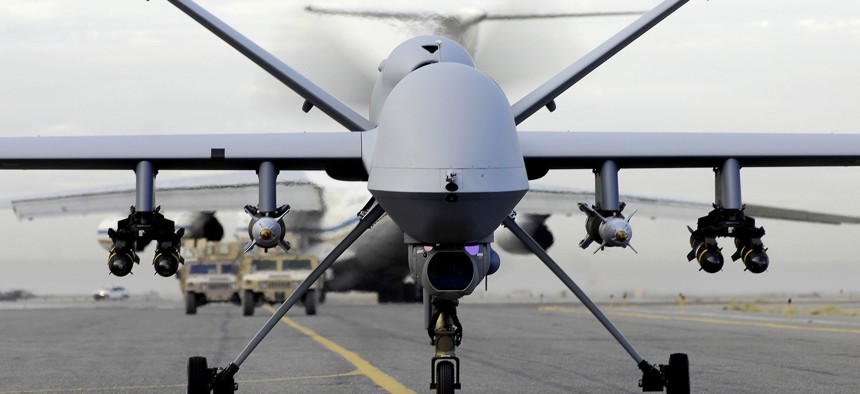
wikipedia.com (public domain)
Why U.S. Drone Policy Foreshadows the Defense Reform Challenge Ahead
Adapting to a more commercialized defense acquisition process will pit DoD's efforts to maintain control over intellectual property against the pressures of the global marketplace.
It’s no secret that there's much to be desired in the way the Department of Defense acquires the technologies and weapon systems required to underpin global security. An endless requirements process, special interest politics, and an oligopolistic defense industry culminate in inflated costs and difficulties harnessing disruptive technologies for U.S. strategic advantage.
A promising new proposal for defense acquisition reform, first advanced in a report by the Center for a New American Security and later in a speech by Deputy Defense Secretary Robert Work, calls for a new “offset” strategy designed to counteract the United States’ flagging technological superiority through greater integration with innovators in the commercial sector. With traditional defense firms devoting less and less to research and development each year, the theory goes that DoD will be better positioned to keep up with the rapid pace of technological change by attracting suppliers tried and tested by the pressures of the global marketplace.
With commercial innovation increasingly outpacing that driven by defense R&D, it seems almost inevitable that DoD will put reforms to improve collaboration with the private sector at the forefront of its strategy. Nevertheless, transitioning to a more commercialized and globalized defense supplier base is not without its own share of challenges.
For established multinationals as well as U.S. start-ups with global aspirations, going into business with the Defense Department can be a risky proposition, given current intellectual property laws that grant DoD considerable control over publicly funded technologies. Despite the prospect of winning huge government contracts, several leading firms have already displayed reluctance to team up with DoD. For example, after acquiring the robotics firm Boston Dynamics, Google famously divested it from all future DARPA contracts citing fears that DoD could assert IP claims over its future designs.
The intricate web of U.S. laws and international agreements governing the trade of defense goods represents another significant hurdle. Since the end of the Cold War, the U.S. and its allies have coordinated wide-ranging export control regimes to prevent sensitive technologies from falling into the hands of hostile nation-states and terrorist organizations. Civilian technologies that are adapted for military applications – everything from rocket engine components to high-performance computer parts – are given “dual-use” status and can be subject to strict licensing by the Departments of State and Commerce. And even then, they must be sold exclusively within the 41 member states adhering to the multilateral Wassenaar Arrangement.
This means that by winning a big defense contract, a firm could actually be at greater risk of having its IP classified as a controlled good, potentially limiting its ability to compete in a global environment.
The inverse might also be true. The transition to a more commercial acquisition strategy will likely put substantial economic pressure on traditional defense suppliers that generate revenue primarily through government contracts. Facing stiffer competition from foreign and domestic challengers, defense contractors are expected to push for greater opportunities to expand their consumer base abroad in order to offset shrinking market share and potential job losses.
The market for unmanned aerial vehicles (UAVs) is case in point.
The United States has long been the global leader UAV technology, in both the military and civilian arenas. In FY 2013, the Defense Department spent $3.8 billion on procurement and R&D for unmanned aerial technology, more than the rest of the world combined. But in accordance with the Arms Export Control Act and the Missile Technology Control Regime (MTCR), U.S. manufacturers are prohibited from selling drone technologies to other countries, including U.S. allies.
This has been the subject of vigorous debate within the national security community. In a June 2014 Council on Foreign Relations report, Micah Zenko and Sarah Krebs argue that U.S. export restrictions are essential to stemming the proliferation of UAV technologies to non-state actors, who could potentially use them as a “DIY air force” and threaten regional stability. Hezbollah, for instance, has been reported to use small surveillance drones within Israeli airspace to spy on troop positions.
Critics fire back that export controls put U.S. companies at a competitive disadvantage vis-à-vis firms from Israel and China – states that choose not to abide by the MTCR. According to Stimson Center expert Mary Cummings, “By not competing in the global marketplace, our drone industry is becoming stagnant…this puts the U.S. at a direct disadvantage.”
At present, 23 countries currently have the capability to produce drones. With the global market expected to grow by over 70 percent to $11.4 billion between now and 2022, the calls for deregulation are only going to grow louder.
As recently as July, the Wall Street Journal reported that State Department officials had been in talks to revise the current rules governing drone sales and hinted that their eventual decision would be “very helpful to exporters and also to our allies.”
The U.S. drone industry is hardly alone in this regard. If drone exports do become more liberalized, who’s to say that other closely-held technologies, including those involved in launching satellites, robotics, or encryption, won’t come next? In any case, the globalization of the defense technology market will have huge implications on global security in the decades ahead.
Commercializing the defense acquisition process could very well become a two-way street: the Department of Defense gains a global market from which to choose the most innovative technologies at the lowest cost; however, it might also mean that the global market accelerates the diffusion of U.S. technological superiority.
This post is written by Government Business Council; it is not written by and does not necessarily reflect the views of Government Executive Media Group's editorial staff. For more information, see our advertising guidelines.



